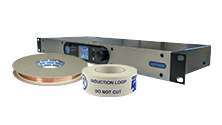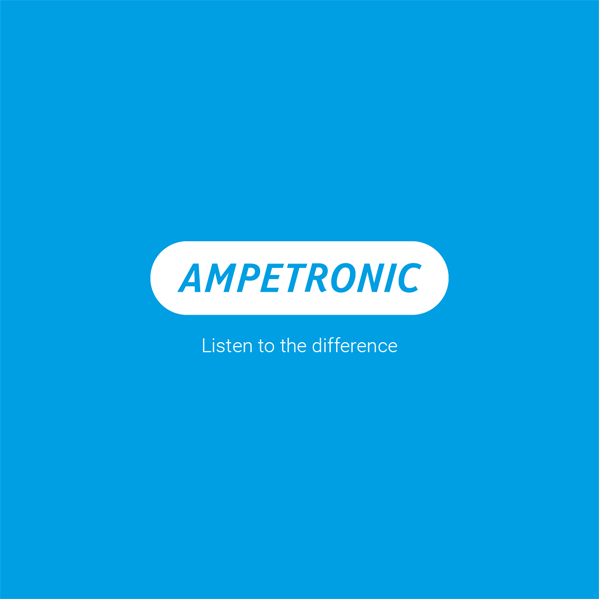What are the advantages of fixed retail counter loops over portable versions?
Retail Counter Hearing Loops are a simple and effective way of allowing people with hearing aids to communicate at retail desks and cash tills in busy environments, where high levels of ambient background noise and challenging acoustics leave even modern digital hearing aids struggling to cope. Portable versions however, are, in my far from unique opinion, responsible for tarnishing the reputation of the technology with the same members of society with hearing loss that they are supposed to help. In this blog I hope to explain why.
Portable Counter Hearing Loops have been on the market for a number of years now, we at Ampetronic are often asked by retail service providers and system installers why we do not manufacture our own version of this type of solution.
The answer is that portable systems are only suitable for a very limited number of applications, such as meeting rooms. Unfortunately, due to their portable nature they tend to lead to a ‘tick box’ approach towards compliance with the Equality Act Of 2010.
Fixed Counter Hearing Loops are Non-Discriminatory.
First and foremost, consider the non-discriminatory nature of a traditional Counter Hearing Loop that is permanently wired into a service desk to become operational whenever a cash till is powered such as the CLD1. The intended user of the system is a member of the public with hearing loss who is already taking advantage of a hearing aid to amplify the sound of those close by and to adjust this sound to suit their specific hearing requirement. To access the Hearing Loop audio that is wirelessly connecting the member of staff’s voice directly to the hearing aid, all the user needs to do is activate the ‘T’ position on their hearing aid, as advertised by the internationally recognised sign at the counter. This in no way requires them to identify themselves as having hearing loss.
When a portable counter Hearing Loop solution has been used there is a high possibility that one system has been purchased by the retail operator to service several counters, however the international Hearing Loop sign is still used at each desk. When the user attempts to connect to the system by activating the ‘T’ position on their hearing aid – nothing happens. The obvious perception is that the system is either broken or simply turned off. This presents three options to the potential user; ask the member of staff to turn the system on (opening them up to potential discrimination), leave without assistance, or struggle to hear the person on the other side of the counter.
Studies suggest that the potential user will either leave or just carry on without asking the member of staff to activate the system – providing no value to the end user.
Poor Staff Training & Bad Maintenance Practice
The portable counter hearing loop solution is designed to meet the needs of the retail service provider, rather than the end user. In large retail operations they are often purchased in bulk and distributed to stores in order to meet the requirements of Equality Act Of 2010 for ‘Assistive Listening’, often with only a single device per venue – without suitable staff training on how to use, maintain or operate them. Saving money on both installation and equipment.
This creates numerous problems that influence the effectiveness of the Hearing Loop Solution
- Incorrect positioning
If the operator does not place the freestanding induction loop system in a pre-defined location that faces the user, with the microphone pointing towards the desired source of sound (the member of staff’s mouth) then it is likely to be vastly reduced in effectiveness and will be unlikely to meet the required IEC 60118-4 Standard of operation. Making it either uncomfortable of impossible to use.
- Frequently not turned on or can’t be found
During a 2011 Action on Hearing Loss survey it was noted that a great many counter systems were either turned off or couldn’t be located by untrained staff. It is very easy for staff to unplug a counter loop that is not hard wired in, usually to make use of the electrical output for something else.
Once they have done this they are unlikely to plug the device back in afterwards if they don’t know what it is for and, as mentioned earlier, people with hearing loss are unlikely to complain or ask to use the service if it isn’t working, simply perpetuating the problem.
THIS BBC VIDEO provides clear examples of all of the problems described in this section.
Microphone Mounted on the Portable Counter Loop
Portable Counter Loops often have an Omni-directional microphone attached/mounted to it (usually on top) for convenience. The problem with this is that the portable loop generally placed a substantial distance from the intended source of sound (the person speaking) and captures all the sound in the environment.
In busy environments this makes the counter hearing loop redundant, and no more useful than the microphone in the hearing aid. The microphone must be both external and directional pointed at the source of the sound (usually the person speaking), it must also be as close to them as possible as an Omni-directional microphone will pick up noise from all directions.
Maintenance and Battery Charging.
Because many freestanding induction loops use rechargeable batteries they can often be very problematic when they are required for use. The devices may be flat, turned off to conserve battery power or simply have gone missing whilst they are charging. If they are low on power or, if turned off, the staff may simply assume that the device is broken because they are inaudible in operation without a hearing aid or receiver. Without specialist testing equipment it is very unlikely that the person whom is responsible for maintaining the loop will even know there are any problems with the device until it is supposed to be used by those with hearing loss.
Produce poor quality audio
Just one of the above problems has the potential to deliver either no signal at all, or poor quality audio, resulting in pointless counter loop system that serves no value to either the user or venue operator.
Because users lose confidence in the technology they no longer ask to use it again. The counter loops are no longer seen as valuable by the operator and the cycle continues.
Counter Hearing Loops are Valuable to Retail Venues
The purple pound represents a large demographic of around 19% of the population, this of course represents a significant trade value with a collective spending power of approximately £80 billion. Combine this with the fact that approximately 1 in 6 of the UK population has some form of hearing loss then it is clear to see that a large proportion of this ‘purple pound’ will be using Assistive Listening Devices such as hearing loops. As the general population ages and as more of us are exposed to higher noise volumes through such things as personal music devices, the amount of those using Assistive Listening Devices is on the rise, those retailers who invest in those with hearing loss will see not only the benefit it provides the end user but also the benefit to their net profit. If nothing else convinces you Equal Access legislation is yet another reason to provide a system that is IEC60118-4 2006 standard compliant.
Counter hearing loops can be a valuable asset to any retail service providing appropriate care has been taken with the installation, proper training has been undertaken by staff and maintenance of the loop is continued throughout its service.
In conclusion there is too much room for error with regards to a freestanding induction loop and it is for this reason that Ampetronic do not manufacture a portable counter loop solution. The CLD1 provides much greater benefit to the user in every aspect. They are more reliable, robust and above all else they do not discriminate against those who have hearing loss.
– By James Flello



